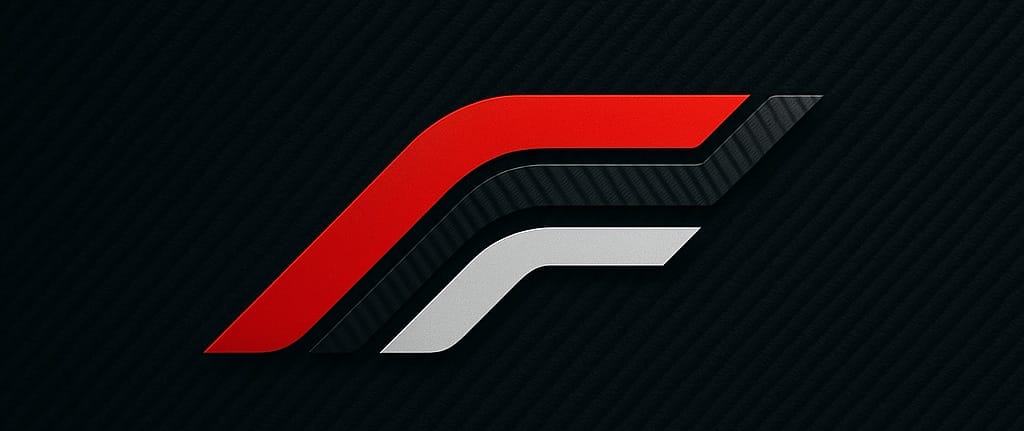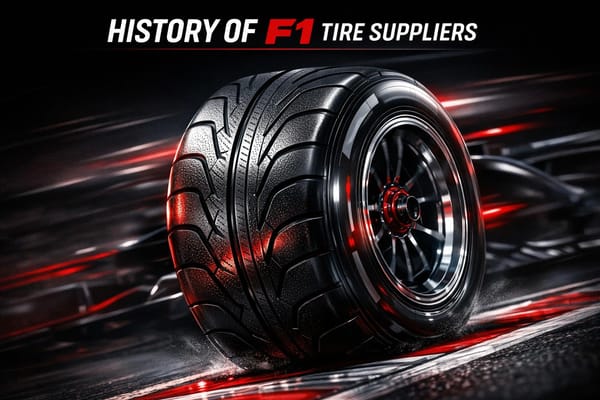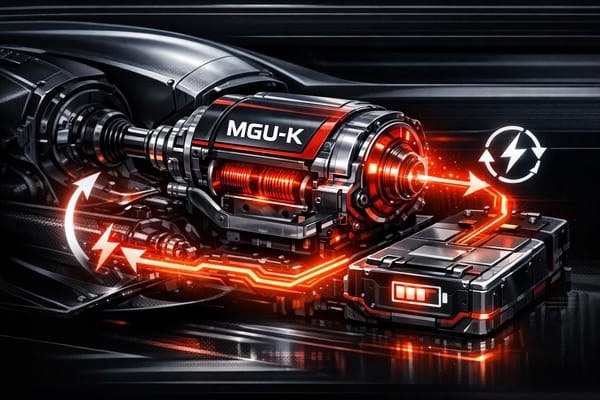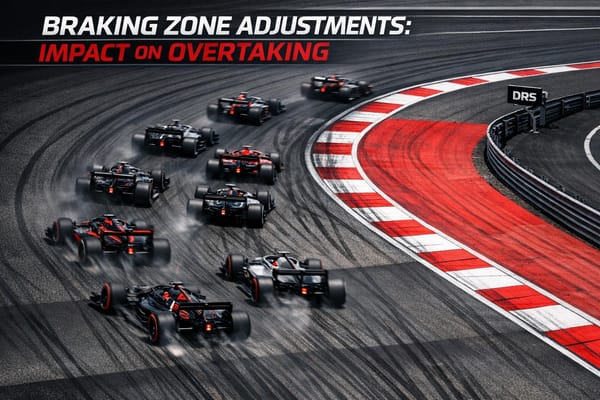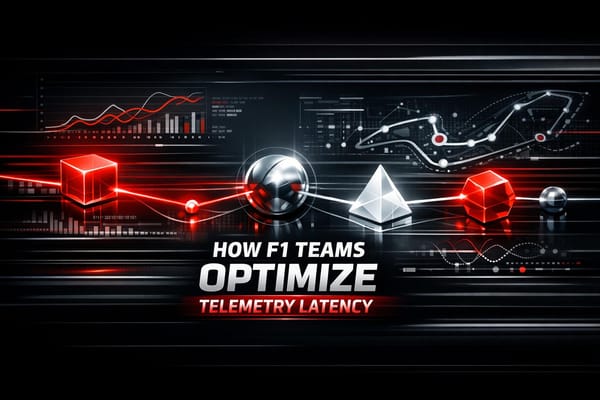Experience the Thrill: Virtual Tours of Famous F1 Tracks
Explore how virtual tours of F1 tracks enhance fan engagement, offering immersive experiences and insights into racing strategies.
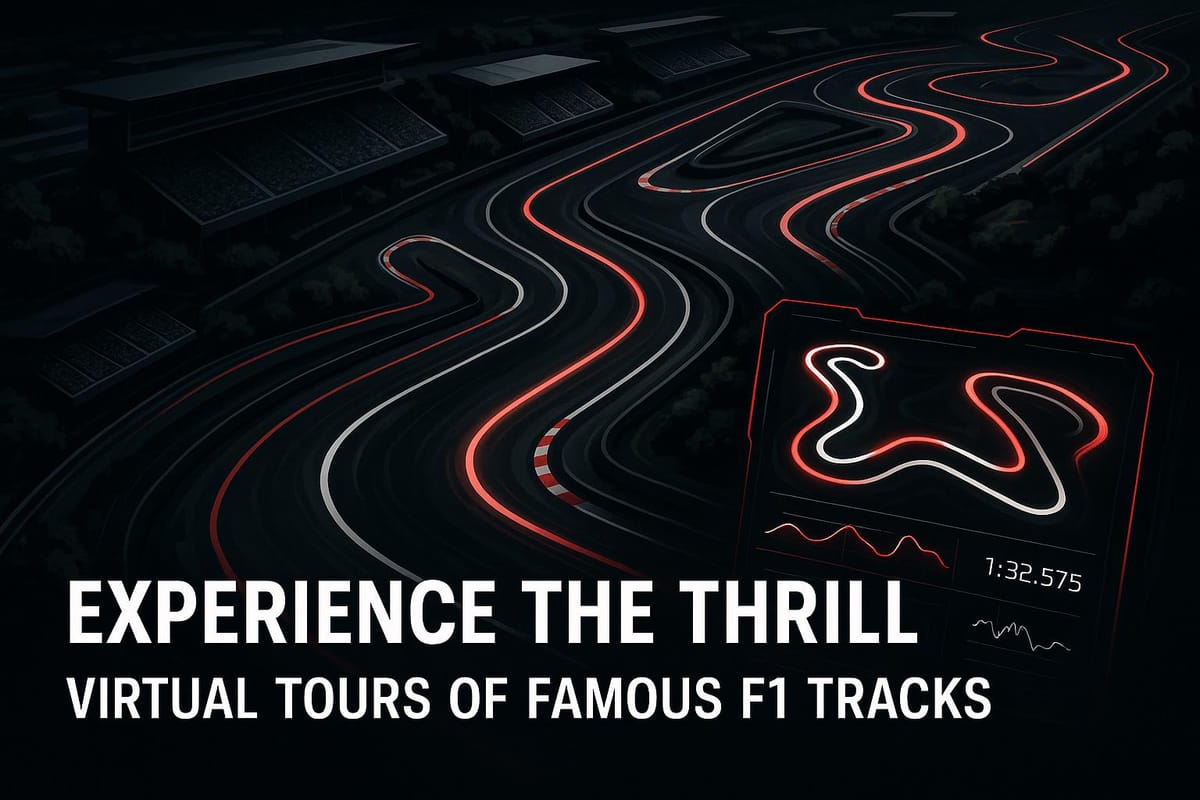
Virtual tours of Formula 1 tracks are changing how fans engage with the sport. Using tools like VR and AR, fans can explore iconic circuits, analyze track details, and even simulate races from home. These tours offer an in-depth look at track layouts, elevation changes, and racing strategies, making the experience more immersive and informative. For those unable to attend races, virtual tours bring the action closer, while attendees benefit from AR-enhanced insights on-site. Platforms like DreamVR and attractions like Las Vegas' Grand Prix Plaza are leading this transformation, blending technology with the thrill of racing. With innovations like AI-driven tools and real-time data overlays, the future of F1 fan experiences is becoming more interactive and engaging.
Monte-Carlo, Monaco • F1 Track Drive Before GP • May 17, 2021 • 360° Virtual Tour 4K HDR
Key Technologies and Platforms for Virtual F1 Tours
Virtual F1 track tours have come a long way, offering fans immersive experiences that bring the thrill of racing right to their fingertips. This section dives into the cutting-edge technology behind these experiences and the platforms making them accessible. Knowing what these tools offer can help fans dive deeper into the world of Formula 1.
Popular Platforms for Virtual F1 Tours
Formula One's initial ventures into virtual reality laid the groundwork for the immersive experiences we see today. These advancements reflect F1’s dedication to giving fans a front-row seat to the action, no matter where they are.
One standout example is the Grand Prix Plaza in Las Vegas, set to open in May 2025. This will be North America's largest F1 attraction, featuring F1® X, an interactive 4D theater experience that lets visitors virtually race on the Las Vegas Strip Circuit.
"Grand Prix Plaza represents a significant investment in the future of Formula 1 in Las Vegas. These new attractions will offer unprecedented access to F1, giving many fans their first up-close look at a Formula 1 car before stepping into a racing simulator or even karting on a portion of the Las Vegas Strip Circuit." – Emily Prazer, President and CEO of Las Vegas Grand Prix, Inc. and Chief Commercial Officer for Formula 1
In addition to physical attractions, interactive web tools have made virtual tours more accessible than ever. These platforms rely on advanced data analytics, processing billions of data points from F1 races. They transform raw race data into interactive experiences, helping fans explore track layouts, racing lines, and strategic decisions like never before.
These platforms are packed with features that elevate the experience for fans of all levels.
Features of Virtual Tour Tools
Modern virtual tour platforms employ a mix of technologies to create unforgettable experiences. For example:
- VR headsets provide cockpit and paddock immersion, while AR overlays offer live, interactive commentary.
- Advanced simulators with motion platforms replicate the feel of racing, offering realistic steering feedback and stunning visuals that mirror the details of actual circuits.
- 3D mapping technology delivers highly detailed virtual representations of tracks, highlighting elevation changes, corner angles, and track surfaces. This helps fans understand how certain overtakes happen and how track characteristics impact strategies.
For the more data-driven fans, interactive data overlays bring race insights to life. Powered by AI and machine learning, these tools analyze race and practice session data to provide real-time telemetry, tire performance stats, and strategic predictions - information that was once exclusive to teams.
These features are designed to work across a range of devices, ensuring fans can enjoy the experience no matter their setup.
Device and Compatibility Options
Virtual F1 tours are accessible on a variety of platforms, including VR headsets like Meta Quest and HTC Vive, as well as mobile devices and PCs. This flexibility ensures fans can engage with the content in ways that suit their preferences.
For fans in the U.S., streaming integration is a game changer. Many virtual tour platforms now sync with live streaming services, allowing fans to switch seamlessly between watching a race and exploring the track virtually.
The investment in these technologies highlights Formula 1’s focus on enhancing fan engagement. While the sport generates annual revenues between $1.5 billion and $2 billion, its digital revenue was just $10 million back in 2017. This disparity has driven significant investment in digital experiences, with teams spending between $100 million and $500 million per season on research and development.
Famous F1 Tracks in Virtual Tours
Virtual tours don’t just show track layouts - they immerse fans in the history, challenges, and technical demands of legendary Formula One circuits. They highlight famous corners, elevation changes, and unique track characteristics that go beyond what you see on TV. Let’s dive into how virtual tours bring two iconic circuits to life.
Monaco Grand Prix Circuit
Monaco is the crown jewel of Formula 1 - a street circuit that commands respect. Virtual tours showcase why this track is so revered. At just 2.074 miles, it’s the shortest circuit on the calendar, but don’t let its size fool you. With a 42-meter elevation change packed into its tight layout, Monaco presents drivers with a dynamic and unforgiving challenge.
On May 14, 2025, Apple Maps introduced a Detailed City Experience for the Formula 1 Grand Prix de Monaco. This update featured custom 3D landmarks like the Casino de Monte-Carlo, Fairmont Monte Carlo, Hôtel de Paris Monte-Carlo, Yacht Club de Monaco, and the F1 Paddock Club. It even marked iconic turns, grandstands, footbridges, and the finish line, giving fans a rich, interactive glimpse of the track.
One standout feature of Monaco is the Fairmont Hairpin, the slowest corner in F1. Cars navigate this tight turn at just 45–50 km/h, a stark contrast to the high-speed straights of other circuits.
"Monaco is very special, I would say, in that sense." – Max Verstappen
Virtual tours also highlight the Casino Square section, where drivers tackle sharp elevation changes while maintaining speed and control. Then there’s the tunnel - an iconic feature where lighting shifts dramatically as drivers move between bright sunlight and shadow, adding another layer of complexity.
"For me, it's the challenge between the driver and the circuit, still unique in #F1." – Mika Häkkinen
Through these virtual experiences, fans gain a deeper appreciation for the precision, skill, and bravery required to conquer Monaco.
Silverstone Circuit
Silverstone, one of F1’s most historic circuits, blends rich heritage with technical challenges. It hosted the first Formula 1 World Championship Grand Prix in 1950, and virtual tours seamlessly weave this history into the experience. Built on the grounds of RAF Silverstone, a former Royal Air Force bomber station (1943–1946), the circuit’s layout still reflects its aviation roots.
Silverstone’s reputation as a high-speed track is immediately clear in virtual tours. Keke Rosberg’s blistering 160 mph average lap speed during 1985 qualifying remains a testament to the circuit’s focus on speed. Virtual tours break down Silverstone’s intricate corner sequences, like the Maggots and Becketts complex. Slow-motion replays showcase how drivers masterfully maneuver through these flowing, high-speed turns. Copse corner, in particular, stands out as a test of sheer courage, requiring drivers to maintain flat-out speeds through what appears to be a simple right-hander.
Another fascinating aspect of Silverstone’s virtual tours is the overlay of historical track layouts. These overlays show how the circuit has evolved over the decades, adapting to modern F1 while staying true to its roots as a high-speed battleground.
Through these detailed digital experiences, fans gain a richer understanding of Silverstone’s legacy and its enduring role as a test of driver skill and performance.
How Virtual Tours Improve F1 Analysis and Fan Engagement
Virtual tours have revolutionized the way fans experience Formula 1, turning what was once a passive activity into an immersive, educational journey. These tools provide a deeper understanding of the sport, bridging the gap between casual spectatorship and detailed technical analysis by giving fans direct access to the strategic intricacies of racing.
Using Virtual Tours for Race Analysis
Virtual tours offer a unique way to explore the dynamics of a race by allowing fans to examine track layouts and identify critical overtaking zones.
For example, LiDAR scans - requiring up to 80 hours to map a 4-mile circuit - create highly detailed models that reveal surface textures, bumps, and curbing. This level of precision helps fans dive into the finer details that can impact race outcomes.
When comparing different circuits, virtual tours showcase how track characteristics influence car performance. Tracks like Hungary and Singapore, known for their high downforce demands, favor cars with exceptional cornering ability. On the other hand, power circuits like Monza and Canada reward vehicles with superior straight-line speed. Street circuits, with their narrow layouts and unforgiving barriers, call for unparalleled precision in driving.
Virtual tours also shed light on tire strategies by highlighting areas prone to wear, helping fans understand why teams select specific tire compounds for each race. Beyond that, they reveal how historical changes to circuits continue to shape modern racing tactics.
Historical Comparisons and Track Changes
One standout feature of virtual tours is their ability to overlay historical and current track layouts, offering fans a clear picture of how regulatory changes have influenced race strategies over time.
These tours also provide a closer look at track surfaces, helping fans grasp how small variations - like surface abrasiveness or curbing - can significantly impact tire wear and car performance. This added layer of detail enhances the appreciation of how teams adapt their strategies to ever-changing conditions.
Interactive Features That Engage Fans
Modern virtual tours go beyond static visuals by incorporating interactive elements and data overlays that transform the viewing experience into an active learning opportunity. These features mirror the tools used by professional racing teams.
Fans can toggle between different viewpoints, such as trackside angles and cockpit perspectives, to better understand the unique challenges each circuit presents. Data visualization tools further enrich the experience by displaying speed traces, braking points, and acceleration zones, letting fans see the split-second decisions drivers make at incredible speeds.
Some virtual tours even integrate real-time telemetry during race weekends. This allows fans to follow live sessions with added technical context, such as how track position influences pit stop strategies or how tire management evolves throughout a race. These interactive tools provide a deeper understanding of the sport, turning race weekends into a more informed and engaging experience.
Practical Tips for Virtual F1 Track Tours
Making the most of a virtual tour of F1 tracks requires a good setup and a clear understanding of the tools at your disposal. With the right hardware and smart viewing strategies, you can turn your screen into a gateway to some of racing's most legendary circuits.
Getting Started with Virtual Tours
Start with the essentials: a dependable device and a fast, stable internet connection. These are non-negotiable for smooth streaming and interaction. If you want to take things up a notch, invest in a VR headset. These headsets provide a cockpit-like experience, simulating the feel of being behind the wheel - similar to the cutting-edge simulators used by F1 teams. Once your tech is ready, shift your attention to creating the best possible viewing environment.
Enhancing Your Virtual Tour Experience
With your setup in place, the next step is optimizing how you experience the tour. High-quality headphones or speakers can make a big difference, letting you pick up on subtle track sounds that add depth to the experience. Interactive features, such as pause and slow-motion tools, are also worth using to examine track details and racing dynamics at your own pace.
Using Virtual Tours During Race Weekends
An optimized setup isn't just for casual exploration - it can be a powerful tool during race weekends. Before the race, use virtual tours to familiarize yourself with the track layout and pinpoint key sections where the action is likely to unfold. During the race, these tours can help you better understand on-track incidents or strategies as they happen. After the event, compare the live action with the virtual track maps to see how the circuit's nuances - captured with advanced methods like lidar scanning, just like F1 teams use - influence the outcome of the race.
The Future of F1 Fan Experiences Through Virtual Tours
The world of Formula One is on the cusp of a transformation, with virtual tours set to redefine how fans connect with the sport. What started as simple 360-degree track views is now evolving into AI-driven, immersive experiences. Thanks to advancements in virtual reality (VR) and augmented reality (AR), these tours are becoming more interactive, offering fans a deeper connection to the action on and off the track.
In early 2024, BlackBox Infinite introduced an F1 + Vision Pro prototype, showcasing how fans could explore race tracks in 3D. Using Apple Vision Pro's eye-tracking technology, the tool adjusted views and information based on where the user looked. The demo quickly gained traction online, racking up over 60 million views and earning praise from tech influencer MKBHD.
"There's no bigger or more powerful showcase for innovation than F1, and VR and AR will push the excitement of the sport even further." - Datau YogaBrata, Winner of the 2016 F1 Connectivity Innovation Prize
The addition of artificial intelligence (AI) is taking these virtual tours to another level by tailoring experiences to individual preferences. In May 2025, Formula 1 and AWS launched 'Real-Time Race Track,' a groundbreaking interactive platform. This feature allows fans to design their own F1 circuits using AI-powered data from Amazon Nova. The system provides insights like top speeds, lap time projections, and even race strategies, including tire choices and pit stop timings under various weather conditions.
"When we first began working with Formula 1, they presented us with a unique challenge – how to use telemetry data to further engage fans during live races. That vision has since materialized into 23 data-driven F1 Insights that appear during the broadcast to help fans better understand how teams devise strategies. With today's launch of the Real-Time Race Track experience, we're taking this approach to a new level of interactivity. Now anyone can design their own circuit and instantly see how weather conditions, track configurations, pit timing, and tire selection influence performance." - Kristin Shaff, Global Director of Strategic Partnerships, AWS
Looking ahead, hardware innovations promise to make these experiences even more lifelike. Imagine using haptic feedback suits, eye-tracking systems, and AR overlays to simulate the feel of racing on an F1 track. Fans could experience the thrill of elevation changes, tight corners, and braking zones with incredible accuracy. Early results from AR-enhanced sports broadcasts already show a 15% boost in viewer engagement and a 20% increase in retention.
Even Lewis Hamilton is excited about the possibilities:
"It is great to be a part of the F1 Connectivity Innovation Prize and to see first-hand fans become part of the F1 action in real time, in addition to watching on their TV or phone. The winning solution from Datu YogaBrata gives us a glimpse of what the future of F1 could look like - and how we will be able to share so much more of our race weekend at the track with people at home. I would love it as a fan!" - Lewis Hamilton, Mercedes AMG Petronas Formula One Team race driver
Virtual tours are also helping Formula One expand its reach globally. With 72% of sports fans in the U.S. using social media to follow their favorite teams and athletes, these experiences create new ways to engage fans who can't attend races in person. Social VR platforms are fostering a sense of community, making F1 more accessible than ever.
"Being a fan is all about passion and finding a sense of belonging and connection, and everyone deserves to experience that. You can't say you're trying to grow the sport if you have an asterisk next to who's welcome." - Dr. Georgia Carroll, PhD in Sociology
The future of F1 fan engagement lies in merging virtual and live experiences. Soon, fans will be able to switch between multiple camera angles during live broadcasts or even virtually "drive" an F1 car. This shift turns passive spectators into active participants, bringing them closer to the heart-pounding action of Formula One.
FAQs
How do virtual F1 track tours bring the excitement of racing to fans at home?
Virtual Formula 1 track tours bring the excitement of iconic circuits like Monaco, Silverstone, and Suzuka right into your living room. These tours let fans dive into the details of track layouts, revisit unforgettable moments in F1 history, and discover the unique features that make each circuit special - all without leaving home.
By recreating the electric atmosphere of a live race, virtual tours offer a taste of the F1 experience for those who can’t attend in person. Plus, they allow fans to navigate the tracks at their own pace, making even the most remote or sold-out events feel within reach. It’s an incredible way to connect with the sport and get closer to the action, no matter where you are.
What technologies bring virtual F1 track tours to life?
Virtual F1 track tours use advanced technology to bring fans an incredibly engaging and lifelike racing experience. Tools like virtual reality (VR) platforms, motion simulators, and haptic feedback systems combine to recreate the thrill of driving on legendary circuits such as Monaco, Silverstone, and Suzuka. From stunning visuals to realistic motion effects and tactile sensations, these systems make you feel like you're truly in the driver’s seat of a Formula 1 car.
What’s more, some platforms go beyond just racing. They let users customize cars, explore track layouts, and even test out race strategies. This adds an extra layer of interaction and helps fans gain a deeper appreciation for the sport. Thanks to these innovations, you can experience the adrenaline of F1 racing without ever leaving your home.
How can virtual tours of F1 tracks help fans understand race strategies better?
Virtual tours of F1 tracks give fans an engaging way to dive into the strategic side of the sport. These tours provide a detailed, immersive look at track layouts, surface textures, and standout features like sharp corners and elevation shifts. This helps fans see how these elements come into play during a race.
Take track layouts, for instance. By exploring them, fans can better understand why teams opt for certain tire compounds, fine-tune braking points, or target specific areas for overtaking. This added layer of insight makes the tactical choices behind each race more accessible and fascinating, enriching the overall viewing experience.
Related posts
- Albert Park Uncovered: The History, Evolution, and Challenges of the Australian Grand Prix Circuit
- Formula 1 and AWS Unveil ‘Real-Time Race Track’ Experience: Empowering Fans to Design and Strategize Their Own Circuits
- How F1 Tracks are Designed: The Art and Science Behind the Curves
- The Evolution of F1 Tracks: A Look at Changes Over the Decades
